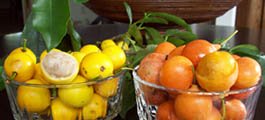Mangosteen plant is an evergreen, upright tree reaching about 20- 60 ft in height. It is commonly found in tropical rainforests of Indonesia, Malaysia, Thailand, and the Philippines, as well as in some cultivated orchards of Sri Lanka and India, where annual precipitation and relative humidity are favorable for its growth. Fresh purple fruits can be available in the markets from June until October.
Each tree bears several deep-purple, round-shaped fruits capped with light green calyx at the stem end. Completely matured fruit measures about 3-7 cm in diameter. Its tough outer rind is about 7-12 mm thick which contains bitter yellow latex that stains clothes black.
Internally; it features 4 to 10 juicy, snow-white, soft, fleshy, triangular segments as in oranges. Each segment may carry 1-4 off-white colored seeds. Seeds are inedible and bitter in taste. The flavor of the fruit can be best described as sweet, mildly tangy, fragrant, and delicious.
 |
| Lemon-drop, and African mangosteens (Imbe). The fruits are smaller than the purple ones. Photo: I like plants |
Different species of Garcinia grown all around Southeast Asia, Africa, and South America all along the tropical belt. Cherapu or Button mangosteen (Garcinia prainiana) is native to Malaysia. It features a somewhat flat, mandarin orange-like shape with a thin rind that can be peeled very easily by hand, again as in oranges.
Lemon drop mangosteens (Garcinia madruno) are small size (2-4 cm diameter) fruits, native to the Malayan peninsula.
African mangosteen or Imbe (Garcinia livingstonei) is native to West Africa. They are slightly larger than the lemon drop type.

